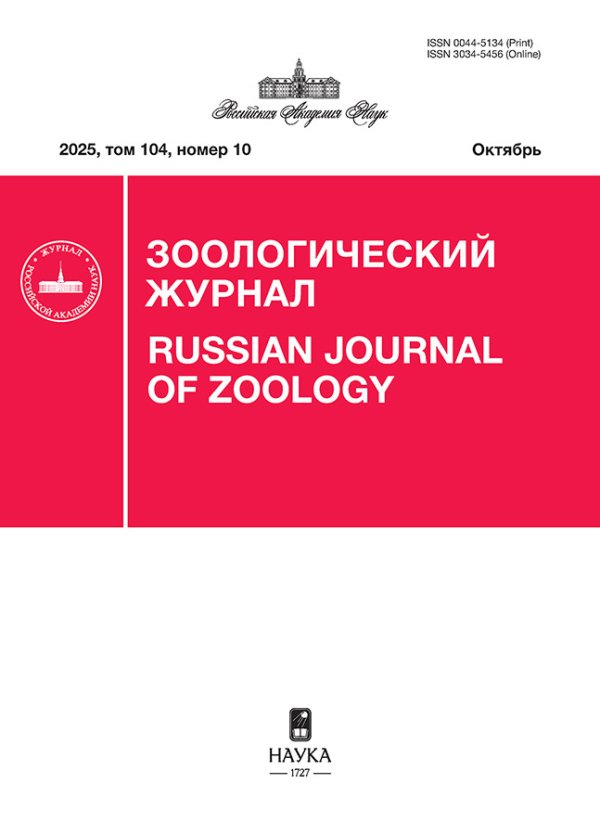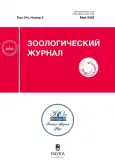Дистанционное отслеживание пространственно-временного распределения западного лесного гуменника (Anser fabalis fabalis, Anseriformes, Aves) в России в контексте его сохранения
- Авторы: Волков С.В.1, Розенфельд С.Б.1
-
Учреждения:
- Институт проблем экологии и эволюции имени А. Н. Северцова РАН
- Выпуск: Том 104, № 5 (2025)
- Страницы: 61-73
- Раздел: Статьи
- URL: https://bakhtiniada.ru/0044-5134/article/view/304862
- DOI: https://doi.org/10.31857/S0044513425050078
- EDN: https://elibrary.ru/auxayj
- ID: 304862
Цитировать
Аннотация
Ключевые слова
Об авторах
С. В. Волков
Институт проблем экологии и эволюции имени А. Н. Северцова РАНМосква, 119071 Россия
С. Б. Розенфельд
Институт проблем экологии и эволюции имени А. Н. Северцова РАН
Email: rozenfeldbro@mail.ru
Москва, 119071 Россия
Список литературы
- Кищинский А.А., 1979. Миграция гуменника по данным кольцевания, полученным в СССР. Общие заключения // Миграции птиц Европы и Северной Азии. Аистообразные – Пластинчатоклювые. М.: Наука. С. 160–163.
- Лебедева М.И., 1979. Миграция гуменника по данным кольцевания, полученным в СССР // Миграции птиц Европы и Северной Азии. Аистообразные – Пластинчатоклювые. М.: Наука. С. 150–160.
- Литвин К.Е., 2014. Новые данные о миграциях гусей, гнездящихся в России. Обзор результатов дистанционного прослеживания // Казарка. Т. 17. С. 13–45.
- Розенфельд С.Б., Замятин Д.О., 2021. Западный лесной гуменник // Красная книга РФ. С. 573–575.
- Розенфельд С.Б., Стрельников Е.Г., Волков С.В., 2024. Маршруты миграции и ключевые остановки Anser fabalis fabalis (Anseriformes): анализ проблем охраны // Nature Conservation Research. Заповедная наука 2024. Т. 9. № 4. С. 80–92.
- Чернецов Н.С., 2023. Изучение миграций птиц сегодня: некоторые достижения и новые сложности // Труды Зоологического института РАН. Т. 327. № 4. С. 607– 622.
- Якушкин Г.Д., Кокорев Я.И., Колпащиков Л.А., 2012. Природные зоны и мир животных Таймыра. Белгород: ЛитКараВан. 276 с.
- Calabrese J.M., Fleming C.H., Noonan M.J., Dong X., 2021. ctmmweb: A Graphical User Interface for Autocorrelation-Informed Home Range Estimation // Wildlife Society Bulletin. V. 45. P. 162–169. https://doi.org/10.1002/wsb.1154
- Chudzińska M.E., Nabe-Nielsen J., Nolet B.A., Madsen J., 2016. Foraging behaviour and fuel accumulation of capital breeders during spring migration as derived from a combination of satellite- and ground-based observations // Journal Avian Biology. V. 47. P. 563–574.
- Féret M., Gauthier G., Béchet A., Giroux J.-F., Hobson K.A., 2003. Effect of a spring hunt on nutrient storage by Greater Snow Geese in southern Québec // Journal of Wildlife Management. V 67. P. 796–807.
- Glahder C.M., Fox A.D., O’Connell M., Jespersen M., Madsen J., 2007. Eastward moult migration of non-breeding pink-footed geese (Anser brachyrhynchus) in Svalbard // Polar Reserch. V. 26. P. 31–36.
- Guo F., Buler J.J., Smolinsky J.A., Wilcove D.S., 2024. Seaso- nal patterns and protection status of stopover hotspots for migratory landbirds in the eastern United States // Current Biology. V. 34. P. 235–244.
- Heinicke T., 2018. Western tundra bean goose Anser fabalis rossicus // A global audit of the status and trends of Arctic and Northern Hemisphere goose populations (Component 2: Population accounts). Conservation of Arctic Flora and Fauna International Secretariat. Akureyri, Iceland. P. 10–13.
- Hijmans R.J., Williams E., Vennes C., Hijmans M.R.J., 2017. Package «geosphere» // Spherical Trigonometry. V. 1. P. 1–45.
- Jensen G., Baveco H., Johnson F., Madsen J., 2022. EGMP Population Status and Assessment Report 2022 // AEWA Technical Report. 56 p.
- Kortesalmi P., Pääkkönen S., Valkonen J.K., Nokelainen O., 2023. Bean Goose migration shows a long-term temporal shift to earlier spring, but not to later autumn migration in Finland // Ornis Fennica. V. 100. P. 61–68.
- Lei J., Jia Y., Zuo A., Zeng Q., Shi L., Zhou Y., Zhang H., Lu C., Lei G., Wen L., 2019. Bird satellite tracking revealed critical protection gaps in East Asian–Australasian Flyway // International Journal of Environmental Research and Public Health. V. 16. 1147. https://doi.org/10.3390/ijerph16071147с
- LeTourneux F., Grandmont T., Dulude-de Broin F., Martin M.C., Lefebvre J., Kato A., Bêty J., Gauthier G., Legagneux P., 2021. COVID19 induced reduction in human disturbance enhances fattening of an overabundant goose species // Biological Conservation. V. 255. 108968.
- Mainguy J., Bêty J., Gauthier G., Giroux J.-F., 2002. Are body condition and reproductive effort of laying Greater Snow Geese affected by the spring hunt? // Condor. V. 104. P. 156–161.
- Marjakangas A., Alhainen M., Fox A.D., Heinicke T., Madsen J., Nilsson L., Rozenfeld S., 2015. International Single Species Action Plan for the Conservation of the Taiga Bean Goose (Anser fabalis fabalis) // AEWA Technical Series. № 56. Bonn, Germany. 88 p.
- Nathan R., Monk C.T., Arlinghaus R., Adam T., Alós J., Assaf M., et al., 2022. Big-data approaches lead to an increased understanding of the ecology of animal movement // Science. V. 375: eabg1780.
- Nilsson C., Klaassen R.H.G., Alerstam T., 2013. Differences in speed and duration of bird migration between spring and autumn // American Naturalist. V. 181. P. 837–845.
- Oppel S., Beeli U.M., Grüebler M.U., van Bergen V.S., Kolbe M., Pfeiffer T., Scherler P., 2024. Extracting reproductive parameters from GPS tracking data for a nesting raptor in Europe // Journal of Avian Biology. e03246. https://doi.org/10.1111/jav.032462024
- Panov I.N., Litvin K.E., Ebbinge B.S., Rosenfeld S.B., 2022. Reasons for the reduction in the population of the Western Subspecies of the Bean Goose (Anser fabalis fabalis and Anser fabalis rossicus): what do the ringing data say? // Biology Bulletin. V. 49. P. 839–850.
- Pekarsky S., Schiffner I., Markin Y., Nathan R., 2021. Using movement ecology to evaluate the effectiveness of multiple human-wildlife conflict management practices // Biological Conservation. V. 262, 109306. https://doi.org/10.1016/j.biocon.2021.109306
- Piironen A., Paasivaara A., Laaksonen T., 2021. Birds of three worlds: moult migration to high Arctic expands a boreal-temperate flyway to a third biome // Movement Ecology. V. 9. 47. https://doi.org/10.1186/s40462-021-00284-4
- Pohlert T., 2018. Trend: non-parametric trend tests and change-point detection. R package version 1.1.5. https://CRAN.R-project.org/package=trend
- R Core Team, 2021. R: A Language and Environment for statistical computing. Vienna: R Foundation for Statistical Computing. Available from https://www.R-project.org
- Romano A., Garamszegi L.Z., Rubolini D., Ambrosini R., 2022. Temporal shifts in avian phenology across the circannual cycle in a rapidly changing climate: a global meta-analysis // Ecological Monographs. V. 93. е1552.
- Salomonsen F., 1968. The moult migration // Wildfowl. V. 19. P. 5–24.
- Schreven K.H., Stolz C., Madsen J., Nolet B.A., 2021. Nesting attempts and success of Arctic-breeding geese can be derived with high precision from accelerometry and GPS-tracking // Animal Biotelemetry. V. 9. P. 1–13.
- Sheehy J., Taylor C.M., Norris D.R., 2011. The importance of stopover habitat for developing effective conservation strategies for migratory animals // Journal Ornithology. V. 152. P. 161–168.
- Sokos C.K., Birtsas P.K., Connelly J.W., Papaspyropoulos K.G., 2013. Hunting of migratory birds: Disturbance intolerant or harvest tolerant? // Wildlife Biology. V. 19. P. 113–125.
- UNEP-WCMC, IUCN, 2023. Protected Planet: The World Database on Protected Areas (WDPA). UNEP-WCMC and IUCN, Cambridge, UK. URL: protectedplanet.net.
Дополнительные файлы










